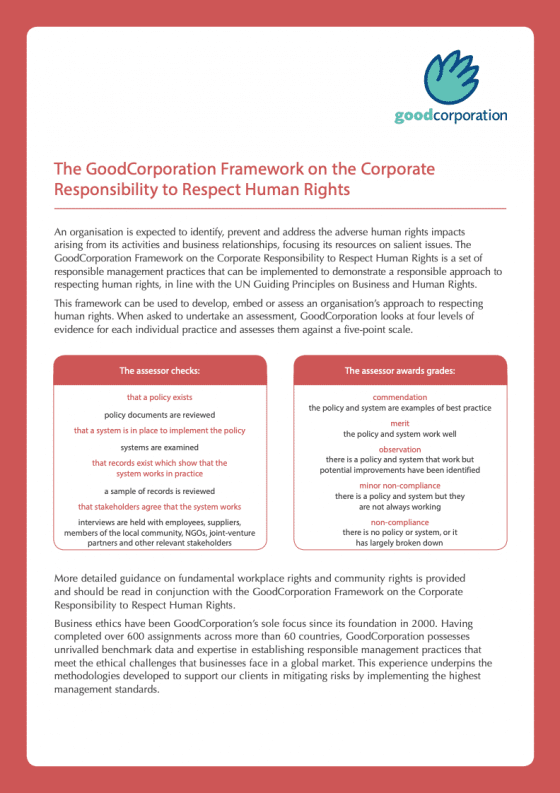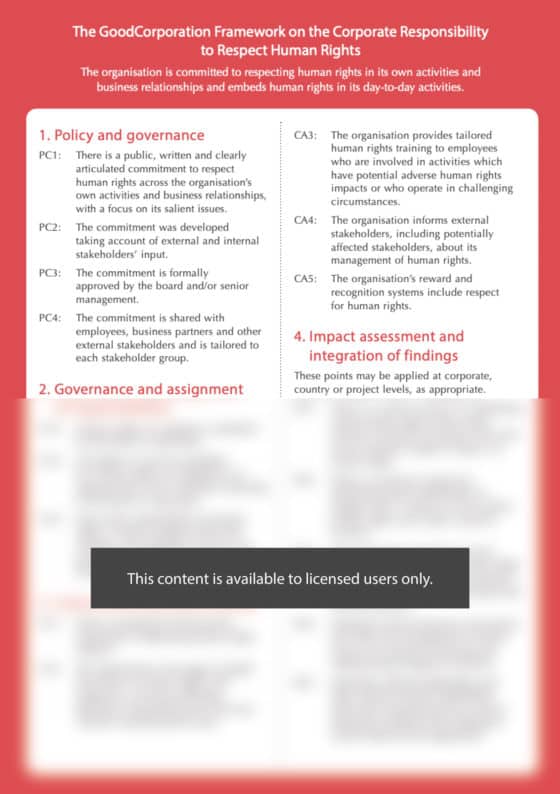We have a vacancy for a Full-Time Manager at our Paris office. Click the link to find out more.
Human rights & modern slavery framework
GoodCorporation's framework on human rights is based on emerging international best practice. It was developed with reference to the UN Guiding Principles on Business and Human Rights, The UN Guiding Principles Reporting Framework, The Modern Slavery Act and The ILO Declaration of Fundamental Principles and Rights at Work.
It covers three key areas: the governance and management of human rights, respecting labour rights and respecting community rights.
The Framework on the Governance and Management of Human Rights covers the structure, governance and management systems needed for a robust approach to identifying, minimising and remedying an organisation's human rights impacts.
Separate documents detail the practices needed to ensure that labour and community rights are protected and respected, with guidance on forced labour, supply chain management, child labour, access to land and the right to security.
They can be used to develop, embed or assess an organisation's approach to respecting human rights.
Areas covered by the Framework on the Governance and Management of Human Rights
- Policy and governance: the organisation has a public, written and clearly articulated statement, approved by the board, to protect and respect human rights across all areas of its activities and in its business relationships.
- Governance and assignment of responsibilities: responsibility for human rights is assigned to an appropriately senior individual with adequate resources and a reporting line to the board.
- Culture and awareness raising: leadership in addressing human rights is shown by senior management who raise the issues faced by the organisation and ensure that staff are aware of the salient risks and the steps needed to mitigate them.
- Risk management and impact assessment: all salient risks are identified with processes in place for devising and implementing mitigation measures.
- Managing business relationships: there are systems and processes in place for identifying and mitigating any human rights risks in the activities of suppliers, service providers or customers and ensure that any M & A due diligence takes account of human rights risks.
- Monitoring and transparency: the organisation regularly reviews the effectiveness of its procedures, reporting to the board, to stakeholders and publicly.
- Remediation: there are accessible channels for raising concerns available to stakeholders supported by an impartial investigation process and remediation mechanisms.
Areas covered by the Framework on Respecting Community Rights
- Stakeholder engagement: the organisation identifies all those likely to be affected by its activities, assesses the possible risks, consults in an appropriate manner and has a plan to manage its impacts.
- Land acquisition and resettlement: the organisation tries to avoid community displacement but where this is unavoidable a process of informed consultation takes place to strive for prior, free and informed consent. Local communities are included in all planning and a commitment is made to maintaining livelihoods and living standards.
- Indigenous peoples: the organisation adapts its engagement strategy according to the characteristics of indigenous peoples to ensure that the consultation process is appropriate and that the correct consent is obtained.
- Gender equality: the organisation's engagement strategy is is gender-sensitive and takes steps to ensure the participation of women in the consultation and also that the needs, concerns and economic prospects of women are addressed in any agreement reached.
- Health, safety and environment: compliance with health, safety and environmental impact is monitored and industry standards adhered to. There is a monitoring programme to reduce any negative impacts as well as a programme to improve sustainability.
- Security: there is a security policy in place and the organisation ensures that any private security personnel are properly recruited, trained and given guidance on human rights. Any instances of abuse by security are recorded and investigated, including allegations of abuses by public security.
- Economic and social development: local communities are supported through policies and projects that promote local employment, businesses and welfare and meet the specific needs of that community.
- Remediation: there are accessible and legitimate channels through which local communities can raise concerns with an impartial process for investigating and responding appropriately.
Areas covered by the Framework on Respecting Labour Rights
- Forced labour: the organisation has a policy prohibiting forced labour and takes steps to ensure that employees are free to leave at any time and that documents and wages are not withheld.
- Child labour: the organisation has a clear policy regarding the minimum age for employment which complies with national law but is no less than 15 years old. There are processes to ensure age verification and that no employee under 18 is engaged in hazardous work.
- Discrimination: the organisation has an equal opportunities policy which is supported in practice. Training on avoiding discrimination is provided and diversity promoted.
- Gender equality and reproductive rights: the organisation does not impose mandatory pregnancy tests or discriminate against pregnant women in way. Access to maternity leave is granted in lines with national and international norms.
- Harassment: the organisation has a policy prohibiting violence and harassment in the workplace. Training on workplace behaviour is provided and any cases properly addressed.
- Freedom of association and collective bargaining: the organisation recognises freedom of association and collective bargaining. Employees are not prevented from joining trade unions or their activities and are allowed to discuss work issues freely where trade unions are not permitted.
- Health and security: there is a policy on workplace health and safety. Risk assessments are conducted to ensure that a safe and healthy work, and, where relevant, living environment are provided.
- Conditions of employment: there is a policy on working hours, conditions and leave in line with international standards. There is a process to monitor compliance with the policy to ensure there is no bullying, harassment, excessive working hours or other areas of poor practice.
- Workers' grievance mechanism: there is a process for raising grievances or concerns that is accessible and communicated to workers. Investigations are impartial and confidentiality respected at all times.
- Responsible purchasing: there is a process in place to ensure that the supplier's capacity to respect labour rights is assessed prior to entering a contractural relationship. Expectations of suppliers are regularly communicated and there are adequate contractural obligations in place in relation to labour rights throughout the supply chain.
Explore our frameworks
Browse our frameworks below and download your copy


